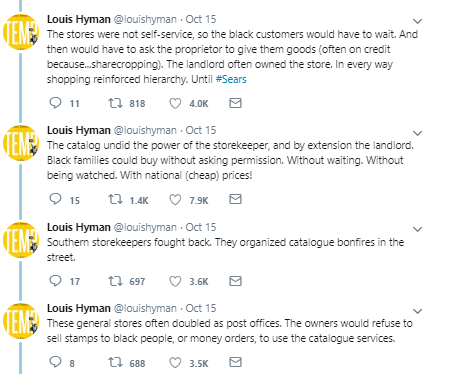The other day on twitter,
Seth Rockman and I were discussing current work on slavery by economic
historians. He thought that there was “more energy being spent policing
"driving force" claims than in generating new findings about
how/where slavery mattered to broader economic transformations.” I told him
that refuting claims like those made by Ed Baptist really doesn’t take that
much effort, and I suggested a list of people that he might want to look at to
see where the energy of economic historians was actually going. This is a much
fuller list than I provided in the tweet, and it provides citations and links (wherever
possible to ungated versions). There are a couple of papers that go back about
ten years, but I think most of the published papers are within the last five
years. Some are still working papers.
As the title of the
post suggests the list includes both papers that are directly about slavery and
papers that are about the political and economic legacy of slavery. Most are
specifically about the U.S. since that is the area I know best, and I tried to
stay focused on economic history, i.e. research that is about understanding the
past. There is also a large literature that focuses on tracing current
conditions to the existence of slavery in the past, see e.g. Nathan Nunn;
Yeonha Jung "How
the Legacy of Slavery Survives: Labor Market Institutions and Demand for Human
Capital." (2018); or Graziella Bertocchi and Arcangelo Dimico. "Slavery,
education, and inequality." European Economic Review 70 (2014): 197-209.
In addition, if you are
interested in recent work on the Atlantic slave trade you might start with Warren Whatley and Rob Gillezeau, or work in progress by Ellora
Derenoncourt “Atlantic Slavery’s Impact on European and British Economic
Development.” Finally, there are other interesting working papers that I know of,
but I try to honor the wishes of authors when they request that preliminary
work not be cited or circulated. You will have to find those papers yourself.
Bodenhorn, Howard. The color factor: The economics
of African-American well-being in the nineteenth-century South. Oxford University
Press, USA, 2015.
Calomiris, Charles W.,
and Jonathan Pritchett. "Betting
on secession: Quantifying political events surrounding slavery and the civil
war." American Economic Review 106, no. 1 (2016): 1-23.
Carruthers, Celeste K.,
and Marianne H. Wanamaker. "Separate
and unequal in the labor market: human capital and the jim crow wage
gap." Journal of Labor Economics 35, no. 3 (2017): 655-696.
Collins, William J.,
and Robert A. Margo.
"Race and Home Ownership from the End of the Civil War to the
Present." American Economic Review 101, no. 3 (2011): 355-59.
Collins, William J.,
and Marianne H. Wanamaker. Up from slavery? African American
intergenerational economic mobility since 1880.
No. w23395. National Bureau of Economic Research, 2017.
Cook, Lisa D. "Violence
and economic activity: evidence from African American patents, 1870–1940." Journal of Economic Growth 19, no. 2
(2014): 221-257.
Cook, Lisa D., Trevon
D. Logan, and John M. Parman. "Racial segregation and southern
lynching." Social Science History42, no. 4 (2018): 635-675. Summary
here.
Craig, Lee A., and
Robert G. Hammond. "Nutrition and signaling in slave markets: a new look
at a puzzle within the antebellum puzzle." Cliometrica 7,
no. 2 (2013): 189-206.
González, Felipe,
Guillermo Marshall, and Suresh Naidu. "Start-up nation? slave
wealth and entrepreneurship in civil war Maryland." The
Journal of Economic History 77, no. 2 (2017): 373-405.
Hornbeck, Richard, and
Suresh Naidu. "When the
levee breaks: black migration and economic development in the American
South." American Economic Review 104, no. 3 (2014): 963-90.
Lander, Kevin, and
Jonathan Pritchett. "When to
Care: The Economic Rationale of Slavery Health Care Provision." Social
Science History 33, no. 2
(2009): 155-182.
Lennon, Conor. "Slave
escape, prices, and the fugitive slave act of 1850." The Journal of Law and
Economics 59, no. 3 (2016):
669-695.
Logan, Trevon D. Do
Black Politicians Matter?. No.
w24190. National Bureau of Economic Research, 2018.
Logan, Trevon D. "A
Time (Not) Apart: A Lesson in Economic History from Cotton Picking
Books." The Review of Black Political Economy 42, no. 4
(2015): 301-322.
Logan, Trevon D., and
Jonathan B. Pritchett. "On
the marital status of US slaves: Evidence from Touro Infirmary, New Orleans,
Louisiana." Explorations in Economic History 69 (2018): 50-63.
Miller, Melinda C. "Land
and racial wealth inequality." American Economic Review 101,
no. 3 (2011): 371-76.
Miller, Melinda C.
"Destroyed by slavery? Slavery and African American family formation
following emancipation." Demography 55, no. 5
(2018): 1587-1609.
Naidu, Suresh. Suffrage, schooling, and sorting
in the post-bellum US South. No. w18129. National Bureau of Economic
Research, 2012.
Olmstead, Alan L., and
Paul W. Rhode. "Cotton,
slavery, and the new history of capitalism." Explorations in Economic
History 67 (2018):
1-17.
Price, Gregory N.,
William A. Darity Jr, and Alvin E. Headen Jr. "Does
the stigma of slavery explain the maltreatment of blacks by whites?: The case
of lynchings." The Journal of Socio-Economics 37, no. 1
(2008): 167-193.
Pritchett, Jonathan,
and Jessica Hayes. "The occupations of slaves sold in New Orleans: Missing
values, cheap talk, or informative advertising?." Cliometrica 10,
no. 2 (2016): 181-195.
Sacerdote, Bruce. "Slavery and the
intergenerational transmission of human capital." Review of Economics and
Statistics 87, no. 2
(2005): 217-234.
Steckel, Richard H.,
and Nicolas Ziebarth. "A
troublesome statistic: Traders and coastal shipments in the westward movement
of slaves." The Journal of Economic History 73, no. 3
(2013): 792-809.
Steckel, Richard H.,
and Nicolas Ziebarth. "Trader Selectivity and Measured Catch-Up Growth of
American Slaves." The Journal of Economic History 76, no. 1 (2016): 109-138.
Sutch, Richard C. The
Economics of African American Slavery: The Cliometrics Debate. No.
w25197. National Bureau of Economic Research, 2018.
Wanamaker, Marianne H.
"Fertility and the
Price of Children: Evidence from Slavery and Slave Emancipation." The Journal of Economic History 74, no. 4
(2014): 1045-1071.















